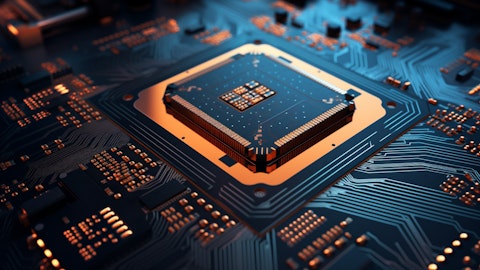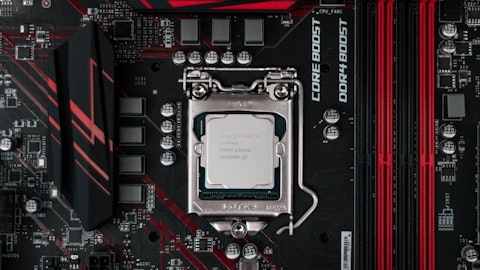ASE Technology Holding Co., Ltd. (NYSE:ASX) Q1 2024 Earnings Call Transcript April 26, 2024
ASE Technology Holding Co., Ltd. isn’t one of the 30 most popular stocks among hedge funds at the end of the third quarter (see the details here).
Ken Hsiang: Hello. I am Ken Hsiang, the Head of Investor Relations for ASE Technology Holdings. Welcome to our First Quarter 2024 Earnings Release. Thank you for attending today. Please refer to our safe harbor notice on Page 2. [Operator Instructions] I would like to remind everyone that the presentation that follows may contain forward-looking statements. These forward-looking statements are subject to a high degree of risk, and our actual results may differ materially. For the purposes of this presentation, dollar figures are generally stated in new Taiwan dollars, unless otherwise indicated. As a Taiwan-based company, our financial information is presented in accordance with Taiwan IFRS. Results presented using Taiwan IFRS may differ materially from results using other accounting standards, including those presented by our subsidiary using Chinese GAAP.
I’m joined today by Joseph Tung, our CFO. For today’s presentation, I will first go over the financial results and give the company guidance. Joseph will then be available to take your questions during the Q&A session that follows. During the Q&A session, each caller will be limited to two questions at a time, but may return to the queue for further questions. With that, let’s get started. As per our expectations, the overall demand environment for our services during the first quarter fell on a sequential quarterly basis, primarily due to seasonality of electronics products. And as was the case at the end of 2023, higher and leading-edge services generally fared better than legacy services. For our ATM business, revenues were on the higher end of our expectations.

During the quarter, key equipment utilization rates were still relatively low, averaging out around 60%. Certain devices initiated a short but unsustained inventory refresh, easing off initially more optimistic outlooks. For our EMS business in the first quarter, demand for our services was slightly ahead of our initial expectations as a result of improving customer inventory levels. Please turn to Page 3, where you will find our first quarter consolidated results. For the first quarter, we recorded fully diluted EPS of $1.28 and basic EPS of $1.32. Consolidated net revenues declined 17% sequentially but increased 1% year-over-year. We had a gross profit of $20.9 billion with a gross margin of 15.7%. Our gross margin declined by 0.3 percentage points sequentially but increased by 0.9 percentage points year-over-year.
The sequential decline in margin is principally due to lower revenues due to seasonality of both our ATM and EMS businesses. The annual improvement in gross margin is principally the result of foreign exchange. Our operating expenses declined by $0.6 billion sequentially, but increased by $1.7 billion annually. The sequential decrease in operating expenses, are primarily due to lower compensation expenses. The year-over-year increase in operating expenses is primarily attributable to R&D staff up, overseas expansion start-up costs and higher incentive stock option expenses. Our operating expense percentage increased 1.3 percentage points sequentially and 1.1 percentage points year-over-year to 10%. The sequential operating expense percentage increase was primarily related to lower operating leverage during our seasonally down quarter.
The annual increase was related to higher R&D staff up, overseas expansion and higher incentive stock option and bonus expenses. Operating profit was $7.5 billion, down $4.3 billion sequentially and down $0.2 billion year-over-year. Operating margin declined 1.7 percentage points sequentially and declined 0.2 percentage points year-over-year. During the quarter, we had a net non-operating gain of $0.4 billion. Our non-operating gain for the quarter primarily consists of net foreign exchange hedging activities, profits from associates and other non-operating income, offset in part by net interest expense of $1.1 billion. Tax expense for the quarter was $1.9 billion. Our effective tax rate for the quarter was 24%. Income tax expense was higher than anticipated, mainly from a tax basis gain realized due to the U.S. dollar appreciation against the Korean won.
See also 15 Countries with the Lowest Saving Rates in Europe and 10 Best Carfax Alternatives to Check Vehicle History.
Q&A Session
Follow Ase Technology Holding Co. Ltd. (NYSE:ASX)
Follow Ase Technology Holding Co. Ltd. (NYSE:ASX)
Receive real-time insider trading and news alerts
Such tax expense may reverse itself when the U.S. dollar depreciates against the Korean won. Net income for the quarter was $5.7 billion, representing a decline of $3.7 billion sequentially and a decline of $0.1 billion year-over-year. The NT dollar appreciated 2% against the U.S. dollar sequentially during the first quarter, while depreciating 2.96% annually. From a sequential perspective, we estimate the NT dollar appreciation had a 0.55 percentage point negative impact to the company’s gross and operating margins. While from an annual perspective, we estimate the NT dollar depreciation had a 0.86 percentage point positive impact to the company’s gross and operating margins. On the bottom of the page, we provide key P&L line items without the inclusion of PPA-related expenses.
Consolidated gross profit, excluding PPA expenses, would be $21.8 billion with a 16.4% gross margin. Operating profit would be $8.7 billion with an operating margin of 6.5%. Net profit would be $6.8 billion with a net margin of 5.1%. Basic EPS, excluding PPA expenses, would be $1.58. On Page 4 is a graphical representation of our consolidated financial performance. On Page 5 is our ATM P&L. The ATM revenue reported here contains revenues eliminated at the holding company level related to intercompany transactions between our ATM and EMS businesses. For the first quarter of 2024, revenues for our ATM businesses were $73.9 billion, down $8.1 billion from the previous quarter and up $0.6 billion from the same period last year. This represents a 10% decline sequentially and a 1% increase annually.
Gross profit for our ATM business was $15.6 billion, down $3.7 billion sequentially and up $0.8 billion year-over-year. Gross profit margin for our ATM business was 21%, down 2.4 percentage points sequentially and up 0.9 percentage points year-over-year. The sequential margin decline was primarily the result of lower revenues due to typical seasonality. The annual margin improvement is primarily the result of foreign exchange offset in part by higher utility costs. During the first quarter, operating expenses were $9.5 billion, down $0.5 billion sequentially, while up $1.2 billion year-over-year. The sequential decline in operating expenses was primarily driven by lower compensation expenses. The annual operating expense increase was driven primarily by scale-up of R&D labor related to leading-edge advanced packaging and, to a lesser extent, the impact of our incentive stock option and bonus programs.
Our operating expense percentage for the quarter was 12.8%, up 0.6 percentage points sequentially and up 1.4 percentage points annually. The sequential operating expense percentage increased as a result of lower operating leverage during the seasonal soft quarter. And noted earlier, the annual increase was due to higher compensation expenses, primarily at the R&D level. From an ongoing basis, we believe that as leading-edge advanced packaging becomes more part of our overall business. A higher concentration of R&D workforce will be required. This will lead to higher compensation expenses within our operating expenses on an absolute basis. However, from a current operating expense percentage perspective, these R&D expenses are ramping ahead of the leading-edge advanced packaging revenues they are to generate in future quarters.
During the first quarter, operating profit was $6.1 billion, representing a decline of $3.1 billion quarter-over-quarter and a decline of $0.3 billion year-over-year. Operating margin was 8.2%, declining 3 percentage points sequentially and declining 0.5 percentage point’s year-over-year. For foreign exchange, we estimate that the NT to U.S. dollar exchange rate had a negative 0.97 percentage point impact on our ATM sequential margins and a positive 1.49 percentage point impact on a year-over-year basis. Without the impact of PPA-related depreciation and amortization, ATM gross profit margin would be 22.2% and operating profit margin would be 9.7%. On Page 6, you’ll find a graphical representation of our ATM P&L. On Page 7 is our ATM revenue by the 3C market segments.
Our communications application shifted 1 percentage point to our computing segment. This shows that applications generally declined together during the seasonally down quarter. On Page 8, you will find our ATM revenue by service type. On a quarter-over-quarter perspective, our revenues didn’t change significantly with a slight shift in percentage share between others and traditional advanced packaging. However, from a year-over-year perspective, there has been a more pronounced shift towards higher-end packaging for both traditional and leading edge. It is worth noting that our stated goal of doubling leading-edge advanced packaging revenues in the current year is tracking somewhat ahead of target. On Page 9, you can see the first quarter results of our EMS business.
Our EMS revenues came in a bit ahead of where we expected, mainly as a result of higher-than-expected customer restocking and an improving customer inventory environment. During the quarter, EMS revenues were $59.4 billion, declining $19.8 billion or 25% sequentially and improving $1.6 billion or 3% year-over-year. The sequential revenue decline is primarily attributable to typical seasonality for EMS business, while the year-over-year revenue improvement is due to higher customer restocking. Sequentially, our EMS business’s gross margin improved 0.9 percentage points to 9.3%. This change was principally the result of product mix. Operating expenses within our EMS business stayed roughly flat with the first quarter at $3.8 billion, declining $0.1 billion sequentially.
Our first quarter operating expense percentage increased 1.6 percentage points sequentially and 0.9 percentage points to 6.5%. The higher operating expense percentage was primarily driven by lower operating leverage while incurring higher global expansion costs. Operating margin for the first quarter declined 0.7 percentage points to 2.8%, which is ahead of our initial expectations due again to product mix. Our EMS first quarter operating profit was $1.7 billion, down $1.1 billion sequentially, while up $0.3 billion annually. On the bottom of the page, you will find a graphical representation of our EMS revenue by application. The moves here are generally in line with the seasonality of underlying customer products. Automotive was a larger portion of segment share driven in part by inorganic growth.
On Page 10, you will find key line items from our balance sheet. At the end of the first quarter, we had cash, cash equivalents and current financial assets of $83.5 billion, increasing $11.5 billion. Our total interest-bearing debt increased slightly by $3.6 billion to $195.3 billion. This increase was primarily related to the impact of the Taiwan dollar depreciating against the U.S. dollar on our U.S. dollar-denominated debt. Total unused credit lines amounted to $393.9 billion. Our EBITDA for the quarter was $24 billion. Our net debt to equity this quarter was down to $0.36 million. On Page 11, you will find our equipment capital expenditures relative to our EBITDA. Machinery and equipment capital expenditures for the first quarter in U.S. dollars totaled $228 million, of which $109 million were used in packaging operations, $97 million in testing operations, $21 million in EMS operations and $1 million in interconnect material operations and others.
We continue to be excited by the prospects of AI and the incremental volumes and package requirements from these increasingly robust devices. We are continuing to see increasing adoptions across our leading-edge advanced packaging services. However, we currently are only at the beginning. We see that the foundations that are being built now will lead to new generations of low, mid, and high-end devices alike. And while AI will bring massive semiconductor volumes, step-ups and package level requirements and corresponding increases in ATM revenues, the vast majority of these devices are just starting to be developed. Going forward, we believe many products may take a fresh AI angle and may create a shorter-than-normal refresh cycle and thus, kick-start overall demand.
As such, although the market recovery appears to be playing out a bit slower than previous customer forecasts, we are not looking to adjust our full year outlook. For the quarter upcoming, we still see a slightly improved demand environment for our services. On the expense side of things, we are seeing some impact to our electricity rate, Tai Power, the provider of electricity to Taiwan has increased electricity rates by 15% for us. The increase goes into effect at the beginning of the second quarter. Further, some rates are starting in the middle of May. The combined effect, we believe, will have a negative 0.8 percentage point impact to our ATM gross margin in the second quarter. Despite this, we are looking to improve our gross margin in the second quarter given improving favorable product mix.
From an operating expense perspective, we still continue to staff up for R&D and incur site expansion costs. However, with revenue improvement, we will look to keep our OpEx percentage flattish or close to the current range. We would like to summarize our outlook for the second quarter 2024 as follows. For our ATM business in NT dollar terms, our ATM second quarter 2024 revenue should grow by mid-single digits quarter-over-quarter. Our ATM second quarter gross margin should be slightly above first quarter 2024 levels. For our EMS business in NT dollar terms, our EMS second quarter 2024 revenues should be similar with the first quarter 2024. Our EMS second quarter 2024 operating margin should be slightly below first quarter 2024 levels. That is the conclusion of our prepared remarks.
I would like to open the floor to questions.
Operator: Now we will start the Q&A session. [Operator Instructions] We have a question from Mr. Gokul Hariharan of JPMorgan.


